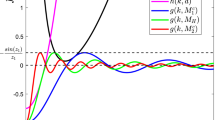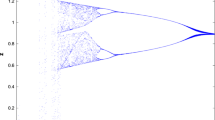Abstract
In this paper, we study a stage-structured single species model with pulse input in a polluted environment. Using the discrete dynamical system determined by the stroboscopic map, we obtain the globally attractive condition for the species-extinction periodic solution of the investigated system. By the use of the theory of impulsive delayed differential equation, we also obtain sufficient condition of the permanence of the investigated system. Our results reveal that long mature period of the population in polluted environment can cause it to go extinct.
Similar content being viewed by others
References
Aiello, W.G., Freedman, H.I.: A time-delay model of single-species growth with stage structure. Math. Biosci. 101(2), 139–153 (1990)
Bainov, D., Simeonov, P.: Impulsive differential equations: periodic solutions and applications. Longman 66 (1993)
Dubey, B.: Modelling the effect of toxicant on forestry resources. Indian J. Pure Appl. Math. 28, 1–12 (1997)
Freedman, H.I., Shukla, J.B.: Models for the effect of toxicant in a single-species and predator–prey systems. J. Math. Biol. 30, 15–30 (1991)
Hallam, T.G., Clark, C.E., Jordan, G.S.: Effects of toxicant on population: A qualitative approach II. First order kinetics, J. Math. Biol. 18, 25–37 (1983)
Hallam, T.G., Clark, C.E., Lassider, R.R.: Effects of toxicant on population: A qualitative approach I. Equilibrium environmental exposure. Ecol. Model 18, 291–340 (1983)
Hass, C.N.: Application of predator–prey models to disinfection. J. Water Pollut. Control Fed. 53, 378–386 (1981)
Hsu, S.B., Waltman, P.: Competition in the chemostat when one competitor produces a toxin. Japan J. Ind. Appl. Math. 15, 471–490 (1998)
Jenson, A.L., Marshall, J.S.: Application of surplus production model to access environmental impacts in exploited populations of Daphnia pluex in the laboratory. Environ. Pollut. (Ser. A) 28, 273–280 (1982)
Jiao, J.J., Chen, L.S.: Delayed stage-structured predator–prey model with impulsive perturbations on predator and chemical control on prey. Appl. Math. Mech. 28(12), 1679–1689 (2007)
Jiao, J., Chen, L.: Global Attractivity of a stage-structure variable coefficients predator–prey system with time delay and impulsive perturbations on predators. Int. J. Biomath. 1(2), 197–208 (2008)
Jiao, J.J., Meng, X.Z., Chen, L.S.: A stage-structured Holling mass defense predator–prey model with impulsive perturbations on predators. Appl. Math. Comput. 189(2), 1448–1458 (2007)
Lakshmikantham, V., Bainov, D.D., Simeonov, P.: Theory of Impulsive Differential Equations. World Scientific, Singapore (1989)
Liu, B., Chen, L.S., Zhang, Y.J.: The effects of impulsive toxicant input on a population in a polluted environment. J. Biol. Syst. 11, 265–287 (2003)
Lu, Z.H., Chen, L.S.: Global attractivity of nonautonomous stage-structured population models with dispersal and harvest. J. Comput. Appl. Math. 166, 411–425 (2004)
Mukherjee, D.: Persistence and global stability of a population in a polluted environment with delay. J. Biol. Syst. 10, 225–232 (2002)
Yang, K.: Delay Differential Equation with Application in Population Dynamics. Academic Press, New York (1987), pp. 67–70
Zhang, B.G.: Population’s Ecological Mathematics Modeling. Qingdao Marine University, Qingdao (1990)
Author information
Authors and Affiliations
Corresponding author
Additional information
Supported by National Natural Science Foundation of China (10647005), and the Nomarch Foundation of Guizhou Province.
Rights and permissions
About this article
Cite this article
Cai, S. A stage-structured single species model with pulse input in a polluted environment. Nonlinear Dyn 57, 375–382 (2009). https://doi.org/10.1007/s11071-008-9448-x
Received:
Accepted:
Published:
Issue Date:
DOI: https://doi.org/10.1007/s11071-008-9448-x




